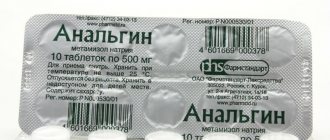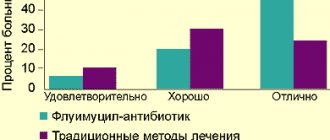GLUCOCORTICOID DRUGS
Toolkit
| Content | ||
| Preface Introduction Pharmacodynamics Pharmacokinetics | Adverse reactions General indications for use Contraindications Characteristics of drugs | Principles of long-term therapy Chronotherapeutic approach Alternating therapy Pulse therapy |
| Peculiarities of use in certain diseases Peculiarities of use in pregnant and lactating women Local application Inhalation administration Intra- and periarticular administration | Application in dermatology Application in ophthalmology and otorhinolaryngology References | |
Instructions for use DEXAMETHASON solution
Allergic reactions may occur (although rarely) during parenteral use of corticoids. Appropriate measures should be taken before starting treatment, taking into account this possibility (especially in patients with a history of allergic reactions to any drugs).
Patients undergoing long-term treatment with dexamethasone may experience corticoid withdrawal syndrome. Therefore, the dosage of dexamethasone should be gradually reduced.
If during therapy or when discontinuing a drug the patient is exposed to unexpected stress (trauma, surgery or serious illness), then the dose of dexamethasone should be increased or hydrocortisone or cortisone prescribed. In patients who have experienced severe stress after discontinuation of long-term dexamethasone, dexamethasone should be restarted as induced adrenal insufficiency may persist for several months after discontinuation of treatment.
Treatment with dexamethasone or natural glucocorticoids may mask signs of existing or new infection and signs of interstitial perforation.
Dexamethasone can aggravate the course of systemic fungal infections, latent amebiasis and pulmonary tuberculosis.
In patients with active pulmonary tuberculosis, dexamethasone should be prescribed (in combination with antituberculosis therapy) in cases of fulminant or severe disseminated pulmonary tuberculosis. Patients with inactive tuberculosis who are taking dexamethasone or patients with a positive tuberculin test should receive chemoprophylaxis.
Particular caution and close medical monitoring should be performed in patients with osteoporosis, hypertension, heart failure, tuberculosis, glaucoma, liver failure, renal failure, diabetes, active gastric and duodenal ulcers, recent intestinal anastomosis, ulcerative colitis and epilepsy. Particular attention should be paid to patients in the first weeks after myocardial infarction, as well as patients with thromboembolism, asthenic bulbar palsy, glaucoma, hypothyroidism, psychosis or psychoneurosis, and elderly patients.
During treatment with dexamethasone, an exacerbation of diabetes or a transition from a latent form to the form of clinical manifestations of diabetes may occur.
During long-term treatment, it is necessary to monitor serum potassium levels. Vaccination with live vaccines is contraindicated during treatment with dexamethasone. Immunization with killed viral or bacterial vaccines does not lead to the expected increase in antibodies and does not have the expected protective effect. Dexamethasone is usually not prescribed 8 weeks before and 2 weeks after vaccination. Patients receiving or taking high doses of dexamethasone for a long time should avoid contact with people with measles; In case of accidental contact, prophylactic treatment with immunoglobulin is recommended. Caution is advised in patients recovering from recent surgery and a bone fracture, as dexamethasone may delay the healing of wounds and fractures.
The effect of glucocorticoids is potentiated in patients with liver cirrhosis or hypothyroidism. Intra-articular administration of corticoids can cause local and systemic effects. Frequent use may cause damage to articular cartilage and bone necrosis.
Before intra-articular injection, synovial fluid should be evacuated from the joint and examined (for possible infection). Injecting corticosteroids into infected joints should be avoided. If septic inflammation of the joint develops after the injection, then appropriate antibacterial treatment must be started.
Patients should be informed that it is necessary to avoid putting stress on the joints into which the injection was performed until the inflammatory process has completely resolved.
Injections into unstable joints are not recommended. Corticosteroids may interfere with allergy skin test results. Dexamethasone is used in children and adolescents only under strict indications. During treatment with dexamethasone, the growth and development of children and adolescents should be carefully monitored.
Special information about some of the ingredients of the drug.
This drug contains less than 1 mmol (23 mg) sodium per dose, which is a negligible amount.
Pregnancy and lactation.
Dexamethasone should be prescribed to pregnant women only in selected urgent cases when the expected benefit to the mother justifies the risk to the fetus.
Particular care should be taken in case of preeclampsia. According to general recommendations for glucocorticoid treatment during pregnancy, the lowest effective dose to control the underlying disease should be used.
Glucocorticoids are excreted in small quantities in breast milk. Therefore, breastfeeding is not recommended for mothers taking dexamethasone, especially when using high physiological doses (about 1 mg). This can lead to fetal growth retardation and decreased secretion of endogenous corticosteroids.
Impact on the ability to drive a car or use other machinery.
Dexamethasone does not affect the ability to drive a car or operate machinery.
CHARACTERISTICS OF INDIVIDUAL DRUGS
Depending on their structure, glucocorticoids differ in duration of action, severity of anti-inflammatory, mineralocorticoid, metabolic and immunosuppressive activity (Table 5). Moreover, there is no direct correlation between their immunosuppressive and anti-inflammatory effects. For example, dexamethasone has a powerful anti-inflammatory effect and relatively low immunosuppressive activity.
CORTISONE
The drug is a natural glucocorticoid, biologically inactive. Activated in the liver, turning into hydrocortisone. Has a short-term effect. Compared to other glucocorticoids, it has more pronounced mineralocorticoid activity, that is, it has a significant effect on water-electrolyte metabolism.
Features of application
Mainly used for replacement therapy
adrenal insufficiency in patients with normal liver function.
Release forms:
- tablets of 25 and 50 mg (cortisone acetate)
.
HYDROCORTISONE
A natural glucocorticoid, its glucocorticoid activity is 4 times weaker than prednisolone, but its mineralocorticoid activity is slightly superior. As with cortisone, there is a high risk of edema, sodium retention, and potassium loss.
Features of application
Hydrocortisone, like cortisone, is not recommended for pharmacodynamic therapy
, especially in patients with edema, hypertension, and heart failure.
It is used
mainly
for replacement therapy
for primary and secondary adrenal insufficiency. In acute adrenal insufficiency and other emergency conditions, the drug of choice is hydrocortisone hemisuccinate.
Release forms:
- hydrocortisone hemisuccinate, dry substance or solution in ampoules and bottles of 100 and 500 mg (hydrocortisone-meva, panukort, solu-cortef)
; - hydrocortisone acetate, suspension in ampoules and vials of 25 mg/ml.
PREDNISOONE
Synthetic glucocorticoid, most often used in clinical practice for pharmacodynamic therapy
and is considered as a standard drug. In glucocorticoid activity it is 4 times stronger than hydrocortisone, and in mineralocorticoid activity it is inferior to it. Refers to glucocorticoids with an average duration of action.
Release forms:
- tablets of 5, 10, 20 and 50 mg (ano-prednisone, decortin N, tednisol);
- prednisolone phosphate, 1 ml ampoules, 30 mg/ml;
- prednisolone hemisuccinate, powder in ampoules of 10, 25, 50 and 250 mg (decortin salt);
- prednisolone acetate, suspension in ampoules of 10, 20, 25 and 50 mg ( prednihexol).
PREDNISONE
In terms of activity and other parameters it is close to prednisolone. Initially, prednisone is a metabolically inactive drug (prodrug). Activated in the liver by hydroxylation and conversion to prednisolone. Therefore, it is not recommended to use it for severe liver diseases. The main advantage of prednisone is its lower cost.
Release forms:
- 5 mg tablets (prednisone).
METHYLPREDNISOLONE
Compared to prednisolone, it has slightly greater (20%) glucocorticoid activity, minimal mineralocorticoid effect, and is less likely to cause undesirable reactions (especially changes in the psyche, appetite, ulcerogenic effect). It has a higher cost than prednisolone.
Features of application
Just like prednisolone, it is used mainly for pharmacodynamic therapy. It is preferable in patients with mental disorders, obesity, peptic ulcer disease, as well as during pulse therapy.
Release forms:
- tablets of 4 and 16 mg (Medrol, Metypred, Urbazon, Prednol);
- methylprednisolone succinate, dry substance in ampoules and vials of 8, 20, 40, 125, 250, 500 mg, 1.0 and 2.0 g (metipred, prednol-L, solu-medrol);
- methylprednisolone acetate, suspension in 40 mg bottles (depo-medrol, metypred);
- methylprednisolone suleptanate, ampoules of 50 and 100 mg/ml (promedrol).
TRIAMCINOLONE
It is a fluorinated glucocorticoid. It has a stronger (20%) and longer-lasting glucocorticoid effect than prednisolone. Has no mineralocorticoid activity. More often causes undesirable reactions, especially from muscle tissue (“triamcinolone” myopathy) and skin (striae, hemorrhages, hirsutism).
Release forms:
- tablets of 2, 4 and 8 mg ( berlicort, delficort, kenacort, polcortolone
);
triamcinolone acetonide, suspension in ampoules of 40 mg/ml ( kenalog, tricort
); - triamcinolone hexacetonide, suspension in ampoules of 20 mg/ml ( Lederspan
).
DEXAMETHASONE
Just like triamcinolone, it is a fluorinated drug. One of the most powerful glucocorticoids: 7 times stronger than prednisolone in glucocorticoid activity. Does not have mineralocorticoid effect. It causes severe depression of the hypothalamic-pituitary-adrenal system, severe disturbances of carbohydrate, fat, calcium metabolism, and a psychostimulating effect, therefore it is not recommended to prescribe it for a long period.
Features of application
The drug has some special indications for use: bacterial meningitis; cerebral edema; in ophthalmology (keratitis, uveitis and others); prevention and treatment of nausea and vomiting during chemotherapy; treatment of severe withdrawal syndrome in alcoholism; prevention of respiratory distress syndrome in premature infants (dexamethasone stimulates the synthesis of surfactant in the alveoli of the lungs); leukemia (replacing prednisolone with dexamethasone in acute lymphoblastic leukemia significantly reduces the incidence of damage to the central nervous system).
Release forms:
- tablets of 0.5 and 1.5 mg (daxin, dexazone, cortidex);
- dexamethasone phosphate, ampoules of 1 and 2 ml, 4 mg/ml (daxin, dexabene, dexazone, sondex).
BETAMETHASONE
A fluorinated glucocorticoid, similar in strength and duration of action to dexamethasone. Glucocorticoid activity is 8-10 times higher than that of prednisolone. Does not have mineralocorticoid properties. It has a somewhat weaker effect on carbohydrate metabolism than dexamethasone. The best known drug is betamethasone phosphate/dipropionate, intended for intramuscular, intra-articular and periarticular administration. It consists of two esters, one of which - phosphate - is quickly absorbed from the injection site and gives a quick (within 30 minutes) effect, and the other - dipropionate - is absorbed slowly, but provides a prolonged effect - up to 4 weeks or more. It is a fine-crystalline suspension that cannot be administered intravenously. Water-soluble betamethasone phosphate is administered intravenously and subconjunctivally.
Dexamethasone, solution for injection 4 mg/ml, ampoules 1 ml, 25 pcs.
Caution should be used in case of parasitic and infectious diseases of a viral, fungal or bacterial nature (currently or recently suffered, including recent contact with a patient) - herpes simplex, herpes zoster (viremic phase), chicken pox, measles, amoebiasis, strongyloidiasis (established or suspected), systemic mycosis; active and latent tuberculosis. Use for severe infectious diseases is permissible only against the background of specific therapy.
It should be used with caution within 8 weeks before and 2 weeks after vaccination, with lymphadenitis after BCG vaccination, with immunodeficiency conditions (including AIDS or HIV infection).
Use with caution in diseases of the gastrointestinal tract: gastric and duodenal ulcers, esophagitis, gastritis, acute or latent peptic ulcers, recently created intestinal anastomosis, nonspecific ulcerative colitis with the threat of perforation or abscess formation, diverticulitis.
Should be used with caution for diseases of the cardiovascular system, incl. after a recent myocardial infarction (in patients with acute and subacute myocardial infarction, the necrotic focus may spread, slowing down the formation of scar tissue and, as a result, rupture of the heart muscle), with decompensated chronic heart failure, arterial hypertension, hyperlipidemia), with endocrine diseases - diabetes mellitus ( including impaired tolerance to carbohydrates), thyrotoxicosis, hypothyroidism, Itsenko-Cushing's disease, with severe chronic renal and/or liver failure, nephrourolithiasis, with hypoalbuminemia and conditions predisposing to its occurrence, with systemic osteoporosis, myasthenia gravis, acute psychosis , obesity (III-IV degree), with poliomyelitis (with the exception of the form of bulbar encephalitis), open- and closed-angle glaucoma.
If intra-articular administration is necessary, it should be used with caution in patients with a general severe condition, ineffectiveness (or short duration) of the action of 2 previous administrations (taking into account the individual properties of the GCS used).
Before and during GCS therapy, it is necessary to monitor a general blood count, glycemic levels and plasma electrolyte levels.
For intercurrent infections, septic conditions and tuberculosis, simultaneous antibiotic therapy is necessary.
Relative adrenal insufficiency caused by dexamethasone may persist for several months after its discontinuation. Taking this into account, in stressful situations that arise during this period, hormonal therapy is resumed with the simultaneous administration of salts and/or mineralocorticoids.
When using dexamethasone in patients with corneal herpes, the possibility of corneal perforation should be kept in mind. During treatment, it is necessary to monitor intraocular pressure and the condition of the cornea.
With the sudden withdrawal of dexamethasone, especially in the case of previous use in high doses, a so-called withdrawal syndrome occurs (not caused by hypocortisolism), manifested by anorexia, nausea, lethargy, generalized musculoskeletal pain, and general weakness. After discontinuation of dexamethasone, relative adrenal insufficiency may persist for several months. If stressful situations arise during this period, GCS is prescribed (according to indications), if necessary in combination with mineralocorticoids.
During the treatment period, monitoring of blood pressure, water and electrolyte balance, peripheral blood picture and glycemic level, as well as observation by an ophthalmologist is required.
In children, during long-term treatment, careful monitoring of the dynamics of growth and development is necessary. Children who during the treatment period were in contact with patients with measles or chickenpox are prescribed specific immunoglobulins prophylactically.
Dexason
Caution should be used in case of parasitic and infectious diseases of a viral, fungal or bacterial nature (currently or recently suffered, including recent contact with a patient) - herpes simplex, herpes zoster (viremic phase), chicken pox, measles, amoebiasis, strongyloidiasis (established or suspected), systemic mycosis; active and latent tuberculosis. Use for severe infectious diseases is permissible only against the background of specific therapy.
It should be used with caution within 8 weeks before and 2 weeks after vaccination, with lymphadenitis after BCG vaccination, with immunodeficiency conditions (including AIDS or HIV infection).
Use with caution in diseases of the gastrointestinal tract: gastric and duodenal ulcers, esophagitis, gastritis, acute or latent peptic ulcers, recently created intestinal anastomosis, nonspecific ulcerative colitis with the threat of perforation or abscess formation, diverticulitis.
Should be used with caution for diseases of the cardiovascular system, incl. after a recent myocardial infarction (in patients with acute and subacute myocardial infarction, the necrotic focus may spread, slowing down the formation of scar tissue and, as a result, rupture of the heart muscle), with decompensated chronic heart failure, arterial hypertension, hyperlipidemia), with endocrine diseases - diabetes mellitus ( including impaired tolerance to carbohydrates), thyrotoxicosis, hypothyroidism, Itsenko-Cushing's disease, with severe chronic renal and/or liver failure, nephrourolithiasis, with hypoalbuminemia and conditions predisposing to its occurrence, with systemic osteoporosis, myasthenia gravis, acute psychosis , obesity (III-IV degree), with poliomyelitis (with the exception of the form of bulbar encephalitis), open- and closed-angle glaucoma.
If intra-articular administration is necessary, it should be used with caution in patients with a general severe condition, ineffectiveness (or short duration) of the action of 2 previous administrations (taking into account the individual properties of the GCS used).
Before and during GCS therapy, it is necessary to monitor a general blood count, glycemic levels and plasma electrolyte levels.
For intercurrent infections, septic conditions and tuberculosis, simultaneous antibiotic therapy is necessary.
Relative adrenal insufficiency caused by dexamethasone may persist for several months after its discontinuation. Taking this into account, in stressful situations that arise during this period, hormonal therapy is resumed with the simultaneous administration of salts and/or mineralocorticoids.
When using dexamethasone in patients with corneal herpes, the possibility of corneal perforation should be kept in mind. During treatment, it is necessary to monitor intraocular pressure and the condition of the cornea.
With the sudden withdrawal of dexamethasone, especially in the case of previous use in high doses, a so-called withdrawal syndrome occurs (not caused by hypocortisolism), manifested by anorexia, nausea, lethargy, generalized musculoskeletal pain, and general weakness. After discontinuation of dexamethasone, relative adrenal insufficiency may persist for several months. If stressful situations arise during this period, GCS is prescribed (according to indications), if necessary in combination with mineralocorticoids.
During the treatment period, monitoring of blood pressure, water and electrolyte balance, peripheral blood picture and glycemic level, as well as observation by an ophthalmologist is required.
In children, during long-term treatment, careful monitoring of the dynamics of growth and development is necessary. Children who during the treatment period were in contact with patients with measles or chickenpox are prescribed specific immunoglobulins prophylactically.




